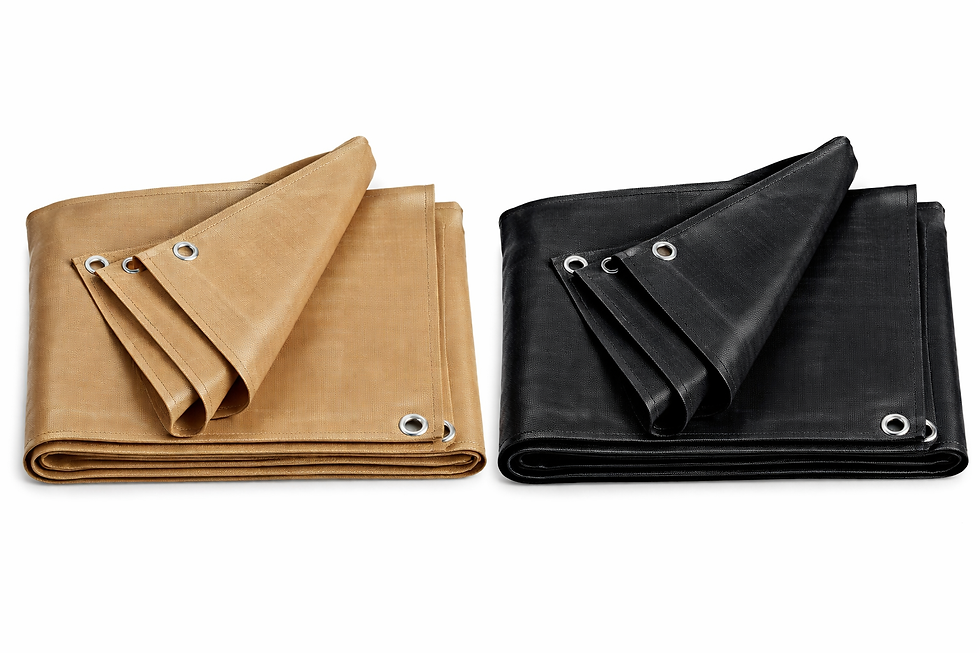Tips for Maintaining Your Transport Tarpaulins
- Bradley Tomlinson

- Jan 1
- 4 min read
Transport tarps or tarpaulins are important in the transportation business since they shield goods from rain, wind, sleet, dust, and potential risks on the way to their destination. No matter what it takes – machines, materials for construction, or vehicles, the Tarpaulins remain an indispensable Tool of protection of the cargo.
But to get the best out of your transport tarps, you need to ensure you treat and maintain them properly. In this blog post, have compiled important facts worth knowing for extending the useful life of transport tarps.
Inspect Regularly
Tarp maintenance still warrants a few checks and it is a requirement for it to be inspected regularly. This means that by regularly inspecting your tarps, you’ll be able to notice any signs of wear and, or damage including holes, tears, or fading – all of which could be a major problem before they escalate.
To perform a thorough inspection, do the following:
Look at the tarp’s joins or overlaps, angles, and edges as they are usually more prone to outside conditions.
Check the tarp adhesion tools like the ropes, ratchet,s or snaps and as a result, ascertain that they are in the correct working order.
Check for deterioration, señor de deterioration like the following: thinning on the edges, change in color, and any areas that seem to be frail.
It won't do to pull too tight or too loose on the tarp as the strain on the material can adversely affect it.
Convection After Each Use
You should make sure to wash and dry the transport tarps after every usage. Cleaning your tarps is important not just to lengthen the useful existence of tarps, but to preserve its ability to serve as a protective barrier. To clean and dry your tarps, follow these steps:
Remove dirt and debris: Dust any debris matter that can easily be removed with a broom or any other piece of light brush.
Hose down: After washing the tarp with soap and water, also ensure you wash the tarp using water through the hose to wash off the dirt and all unwanted elements.
Mild detergent: If required, then wash it with a soft soap or gentle detergent but remember it is not recommended to wash it with hard soap. Do not use any strong acids, detergents, or bleaches because these things may spoil the fabric of the uniform.
Allow to dry: Wash the tarp, and dry either drying it by hanging or somewhere flat. Do not dry it using a dryer or any dryer methods like ironing because it will compromise the fabric's strength.
Store Properly
This is more important because how you store your transport tarps may affect their longevity. Be specific about keeping them properly when you are not using them so that they do not get damaged or worn out when they do not have to be. To store your tarps, follow these steps:
Avoid direct sunlight: If you are dry and cool area, these should be stored in a place without moisture and sunlight. UV radiation in effect causes the fabric to wear out and lose its color with time.
Avoid heat: Tarps are sensitive to heat and light and ought to be stored in a cool dry area away from sources of heat.
Avoid moisture: Fold store tarps properly to ensure they do not develop moisture, this would harm the tarps by developing mold, mildew, or rust.
Use storage bags: For the preservation of tarpaulins from dust, dirt, and other materials, it is recommended that you store them in storage bags or containers with a closed lid.
Fastening Systems
Correct fastening systems need to be utilized to ensure that your tarps do not end up somewhere else or blown away during transport. An unsecured Heavy Duty Tarpaulin can even lead to the loss of the shipment cargo or even the failure of the tarp. To ensure your tarps are properly secured, use the following methods:
Secure corners: Tarps with reinforced edges or reinforced corner grommets are particularly suitable.
Use ropes or straps: Tarp tie-downs, or cable ties, ought to be ropes, straps, or bungee cords that would help you secure the tarp to your stowage or the trailer.
Utilize ratchets: The hardware used included ratchets which enable easy tightening and adjustment with the added advantage of providing security to the tarp.
Check fastening points: Check your fastening systems often and then repair or replace the parts that are damaged or worn out.
Tarp Buying Guide: How to Choose the Right Tarp
The effectiveness of a tarp depends heavily on the decision made in the selection of a proper and superior tarp designed for the requirements of the involved application. Consider the following factors when choosing a tarp:
Material: Choose a tarp made from weatherproof materials like polyethylene, vinyl, or canvas.
Thickness: A thicker tarp is preferable if one is carrying big or fragile goods that need even more coverage.
Size and shape: Go with the tarp that will readily fit over the cargo and its shape, so that the tarp doesn’t bunch or sag.
Water resistance: In the election of a tarp for outdoor transport make sure that it is made from a material that is capable of resisting the water.
Properly Load Your Cargo
Last but not least; make sure your cargo is properly loaded and strapped so as not to harm your tarps or the cargo in transit. When loading your cargo, follow these guidelines:
Use the right equipment: The cargo should be fastened in such a manner that it doesn't move either during motion because you need to secure the cargo.
Center of gravity: Make sure that they don’t overload the tarp and that the center of gravity of the cargo is well aligned.
Overlap tarps: When one is using more than one tarpaulin for covering the cargo ensure that they are joined in such a way that there is no space for wind uplift.
Conclusion
Transport Tarps are an important part of the transport and logistics industry since they provide the necessary cover for transported goods. To maximize the lifespan and effectiveness of your transport tarps, follow these essential maintenance tips: Check, wash, whatever you do with it, secure, install the best tarp, and stack your cargo most appropriately. By following these guidelines you will be able to protect your cargo, preserve your tarpaulins, and prolong their usage.









Comments